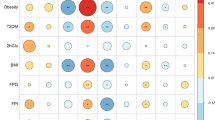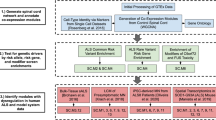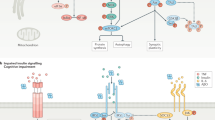Abstract
Alström syndrome is a homogeneous autosomal recessive disorder that is characterized by childhood obesity associated with hyperinsulinemia, chronic hyperglycemia and neurosensory deficits1,2. The gene involved in Alström syndrome probably interacts with genetic modifiers, as subsets of affected individuals present with additional features such as dilated cardiomyopathy3, hepatic dysfunction4, hypothyroidism5, male hypogonadism, short stature and mild to moderate developmental delay, and with secondary complications normally associated with type 2 diabetes, such as hyperlipidemia and atherosclerosis. Our detection of an uncharacterized transcript, KIAA0328, led us to identify the gene ALMS1, which contains sequence variations, including four frameshift mutations and two nonsense mutations, that segregate with Alström syndrome in six unrelated families. ALMS1 is ubiquitously expressed at low levels and does not share significant sequence homology with other genes reported so far. The identification of ALMS1 provides an entry point into a new pathway leading toward the understanding of both Alström syndrome and the common diseases that characterize it.
This is a preview of subscription content, access via your institution
Access options
Subscribe to this journal
Receive 12 print issues and online access
$259.00 per year
only $21.58 per issue
Buy this article
- Purchase on SpringerLink
- Instant access to full article PDF
Prices may be subject to local taxes which are calculated during checkout





Similar content being viewed by others
References
Alström, C.H., Hallgren, B., Nilsson, L.B. & Åsander, H. Retinal degeneration combined with obesity, diabetes mellitus and neurogenous deafness. A specific syndrome (not hitherto described) distinct from Laurence-Moon-Biedl syndrome. A clinical endocrinological and genetic examination based on a large pedigree. Acta Psychiatr. Neurol. Scand. 34 (suppl. 129), 1–35 (1959).
Goldstein, J.L. & Fialkow, P.J. The Alström syndrome. Report of three cases with further delineation of the clinical, pathophysiological, and genetic aspects of the disorder. Med. Baltimore 52, 53–71 (1973).
Michaud, J.L. et al. Natural history of Alström syndrome in early childhood: onset with dilated cardiomyopathy. J. Ped. 128, 225–229 (1996).
Connolly, M.B. et al. Hepatic dysfunction in Alström Disease. Am. J. Med. Genet. 40, 421–424 (1991).
Charles, S.J., Moore, A.T., Yates, J.R., Green, T. & Clark, P. Alstrom's syndrome: further evidence of autosomal recessive inheritance and endocrinological dysfunction. J. Med. Genet. 27, 590–592 (1990).
Collin, G.B., Marshall, J.D., Cardon, L.R. & Nishina, P.M. Homozygosity mapping of Alström syndrome to chromosome 2p. Hum. Mol. Genet. 6, 213–219 (1997).
Collin, G.B. et al. Alström syndrome: further evidence for linkage to human chromosome 2p13. Hum. Genet. 105, 474–479 (1999).
Macari, F. et al. Refinement of genetic localization of the Alström syndrome on chromosome 2p12-13 by linkage analysis in a North African family. Hum. Genet. 103, 658–661 (1998).
Hearn, T. et al. Mutation of ALMS1, a large gene with a tandem repeat of 47 amino acids, causes Alström syndrome. Nature Genet. 31 (2002); advance online publication, (DOI:10.1038/ng874).
Marshall, J.D. et al. Genealogy, natural history, and phenotype of Alström syndrome in a large Acadian kindred and three additional families. Am. J. Med. Genet. 73, 150–161 (1997).
Kopelman, P.G. Obesity as a medical problem. Nature 404, 635–643 (2000).
Froguel, P. & Velho, G. Genetic determinants of type 2 diabetes. Recent Prog. Horm. Res. 56, 91–105 (2001).
Naggert, J., Harris, T. & North, M. The genetics of obesity. Curr. Opin. Genet. Dev. 7, 398–404 (1997).
Slavotinek, A.M. et al. Mutations in MKKS cause Bardet-Biedl syndrome. Nature Genet. 26, 15–16 (2000).
Mykytyn, K. et al. Identification of the gene that, when mutated, causes the human obesity syndrome BBS4. Nature Genet. 28, 188–191 (2001).
Nishimura, D.Y. et al. Positional cloning of a novel gene on chromosome 16q causing Bardet-Biedl syndrome (BBS2). Hum. Mol. Genet. 10, 865–874 (2001).
Katsanis, N. et al. Triallelic inheritance in Bardet-Biedl syndrome, a Mendelian recessive disorder. Science 293, 2256–2259 (2001).
Inui, A. Feeding and body-weight regulation by hypothalamic neuropeptides–mediation of the actions of leptin. Trends Neurosci. 22, 62–67 (1999).
Kunkel, L.M. et al. Analysis of human Y-chromosome-specific reiterated DNA in chromosome variants. Proc. Natl Acad. Sci. USA 74, 1245–1249 (1977).
Rastogi, P.A. MacVector. Integrated sequence analysis for the Macintosh. Methods Mol. Biol. 132, 47–69 (2000).
Collin, G.B. et al. Physical and genetic mapping of novel microsatellite polymorphisms on human chromosome 19. Genomics 37, 125–130 (1996).
Nishina, P.M., North, M.A., Ikeda, A., Yan, Y. & Naggert, J.K. Molecular characterization of a novel tubby gene family member, TULP3, in mouse and humans. Genomics 54, 215–220 (1998).
Acknowledgements
We are greatly indebted to the individuals with Alström syndrome and their families for their participation in this study. We thank the laboratory of D.I. Wilson for sharing 5′ cDNA sequence information; Alström Syndrome International; the Center for Human Genetics, Bar Harbor, Maine; A.V. Levin; R. Weksburg and M.D. Ludman for referral of patients and D. McMinimy, J.H. Kim, J. Hurd and T. Radcliffe for technical assistance. We also thank E. Leiter and S. Ackerman for critical review of this manuscript. This study was supported by grants from the National Institutes of Health and the American Diabetes Association (to P.M.N.). Institutional shared services were supported by a National Cancer Institute Support grant (to P.M.N. and J.K.N.). Support of the clinical assessment of Kindred 57 was provided by a grant from M.I.U.R. (to N.S.).
Author information
Authors and Affiliations
Corresponding author
Supplementary information
Rights and permissions
About this article
Cite this article
Collin, G., Marshall, J., Ikeda, A. et al. Mutations in ALMS1 cause obesity, type 2 diabetes and neurosensory degeneration in Alström syndrome. Nat Genet 31, 74–78 (2002). https://doi.org/10.1038/ng867
Received:
Accepted:
Published:
Issue date:
DOI: https://doi.org/10.1038/ng867
This article is cited by
-
Mutation identification and prediction for severe cardiomyopathy in Alström syndrome, and review of the literature for cardiomyopathy
Orphanet Journal of Rare Diseases (2022)
-
Alström syndrome: an ultra-rare monogenic disorder as a model for insulin resistance, type 2 diabetes mellitus and obesity
Endocrine (2021)
-
Loss of the centrosomal protein Cenpj leads to dysfunction of the hypothalamus and obesity in mice
Science China Life Sciences (2021)
-
Recessive ciliopathy mutations in primary endocardial fibroelastosis: a rare neonatal cardiomyopathy in a case of Alstrom syndrome
Journal of Molecular Medicine (2021)
-
A very early diagnosis of Alstrӧm syndrome by next generation sequencing
BMC Medical Genetics (2020)



